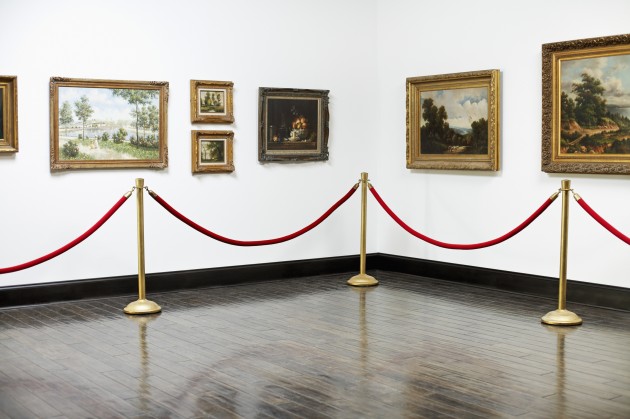Friday 18th September 2015Secret Nazi Treasure Train Discovered?
It seems like a story out of an Indiana Jones adventure, rather that a story that belongs here on an art blog - but for some lucky posts, those two ideas can blend together into something that barely sounds real. Authorities aren't entirely certain it is true, as the story is still unfolding, but regardless it's a tale worth telling. It's not quite a new one, as it seems impossible for more than a couple of months to go by without a new artistic treasure trove being discovered somewhere in the world.
This latest trove has supposedly been found in Poland, and has already inspired a wild series of speculations about what might be contained within it - but nobody has any idea for certain. The find was discovered by two anonymous tipsters who are claiming that it is a World War II era train stuffed to the brim with valuable art, gold, and jewels.
"In the documents they sent us, they inform us that they have found a military train from the second World War and that outside the train some guns and weapons can be seen," confirmed Marika Tokarska, a local municipal official. "They also said there could be gold and some other precious things inside."
The real issue comes from the fact that the two tipsters won't share the location of their fund until they are guaranteed a 10% finder's fee for revealing the location. Under Polish law, any discovered weapons must be immediately reported to the police, which puts the two men in a sticky position as they're unwilling to do this. The authorities are also concerned that there may be some serious danger in the train as well, especially if it's as loaded with valuables as the tipsters claim. Considering the military nature of the train, it's quite possible that the train has been mined to prevent tampering, or that methane gases have built up in the abandoned tunnels, ready to be triggered by a simple static spark.
With every new treasure trove that's discovered, whether they're verified or merely speculative, it's a reminder of how devastating war and greed can be to all aspects of life. Not just the human cost of suffering, but the damage being done to humanity's cultural legacy.
Posted on September 18th 2015 on 01:11am
0 Comments
Monday 25th August 2014More Works in the Art Trove

If you read the news on a regular basis - or this blog - you'll probably remember hearing about a stash of artwork that was found in Germany recently in the house of an aging and now deceased collector. Discovered in the Munich apartment of Cornelius Gurlitt, who died in May of this year, the surprising number of works - well over 1200, at last count - were at first considered as a means of settling the debts he had incurred due to tax evasion, until it was discovered how valuable many of the pieces are. The German government assigned a team to research the works and their provenance, and came to the awkward conclusion that many of them were likely looted by the Nazi armies of World War Two. There was immediate outrage that the government hadn't come forwards with the news to assist in restitutions to the families whose property had been stolen so many years ago. When news of another trove in Salzburg, Austria surfaced, further excitement and media speculation settled on the reclusive Gurlitt, who left his entire collection to the Kunstmuseum Bern in Switzerland.
Recently, however, it has come to light that there are two more unexpected works by grand masters in the collection, which has come to be known as the Munich Art Trove. While it's not yet completely confirmed, it appears that two sculptures found in the Trove are actually works by Auguste Rodin and Edgar Degas. The German government currently maintains a website full of images of stolen and looted artwork, and these pieces will definitely be added to the collection in the hopes of connecting them with their previous owners. To date, only one of the looted pieces has been returned to a verified owner, a Matisse portrait that was the property of Paul Rosenberg, although now that Gurlitt has died, there is a long grinding bureaucratic process underway to wade through before the piece will actually be returned.
With any luck, the image databank run by the government and the dedicated art sleuthing by the investigative team in charge of verifying the artworks will quickly have these masterpieces returned to their rightful owners, where the art world can once again appreciate the grandeur of the European artists' missing works.
Posted on August 25th 2014 on 12:42pm
0 Comments
 It seems like a story out of an Indiana Jones adventure, rather that a story that belongs here on an art blog - but for some lucky posts, those two ideas can blend together into something that barely sounds real. Authorities aren't entirely certain it is true, as the story is still unfolding, but regardless it's a tale worth telling. It's not quite a new one, as it seems impossible for more than a couple of months to go by without a new artistic treasure trove being discovered somewhere in the world.
It seems like a story out of an Indiana Jones adventure, rather that a story that belongs here on an art blog - but for some lucky posts, those two ideas can blend together into something that barely sounds real. Authorities aren't entirely certain it is true, as the story is still unfolding, but regardless it's a tale worth telling. It's not quite a new one, as it seems impossible for more than a couple of months to go by without a new artistic treasure trove being discovered somewhere in the world. If you read the news on a regular basis - or this blog - you'll probably remember hearing about a stash of artwork that was found in Germany recently in the house of an aging and now deceased collector. Discovered in the Munich apartment of Cornelius Gurlitt, who died in May of this year, the surprising number of works - well over 1200, at last count - were at first considered as a means of settling the debts he had incurred due to tax evasion, until it was discovered how valuable many of the pieces are. The German government assigned a team to research the works and their provenance, and came to the awkward conclusion that many of them were likely looted by the Nazi armies of World War Two. There was immediate outrage that the government hadn't come forwards with the news to assist in restitutions to the families whose property had been stolen so many years ago. When news of another trove in Salzburg, Austria surfaced, further excitement and media speculation settled on the reclusive Gurlitt, who left his entire collection to the Kunstmuseum Bern in Switzerland.
If you read the news on a regular basis - or this blog - you'll probably remember hearing about a stash of artwork that was found in Germany recently in the house of an aging and now deceased collector. Discovered in the Munich apartment of Cornelius Gurlitt, who died in May of this year, the surprising number of works - well over 1200, at last count - were at first considered as a means of settling the debts he had incurred due to tax evasion, until it was discovered how valuable many of the pieces are. The German government assigned a team to research the works and their provenance, and came to the awkward conclusion that many of them were likely looted by the Nazi armies of World War Two. There was immediate outrage that the government hadn't come forwards with the news to assist in restitutions to the families whose property had been stolen so many years ago. When news of another trove in Salzburg, Austria surfaced, further excitement and media speculation settled on the reclusive Gurlitt, who left his entire collection to the Kunstmuseum Bern in Switzerland.



